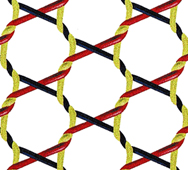Bobbinet
Machines based on his original designs are still in operation today producing fabrics in Perry Street, Chard, Somerset, UK.
Lace has been produced for a long time, made in tedious hand labour with thin thread and needles or bobbins.
The beards were simultaneously depressed by a presser bar catching the weft and holding it back a course making a row of loops.
After Strutt had modified the machine in 1759 to do ribbing, Hammond in 1764 used a tickler stick to transfer the loops 2 or 3 gaits sideways, and mechanic lace making was born.
He studied the hand movements of a Northamptonshire manual lace maker and reproduced them in the roller-locker machine.
The smooth, unpatterned tulle produced on these machines was on a par with real, handmade lace net.
These technical applications include sunblinds for cars and railway coaches, safety nets, parachute skirting, radar reflective fabrics for military decoys, flexible textile switches and sensor, as well as light control fabrics for the film and theatre industries.


- Bobbinet (métier bobin) schematic. The bobbinet framework consists of:
- A - Warp beam
- B - Lace take up roller
- C - Represents the combs or guides, with two brass-bobbins in their carriers.
